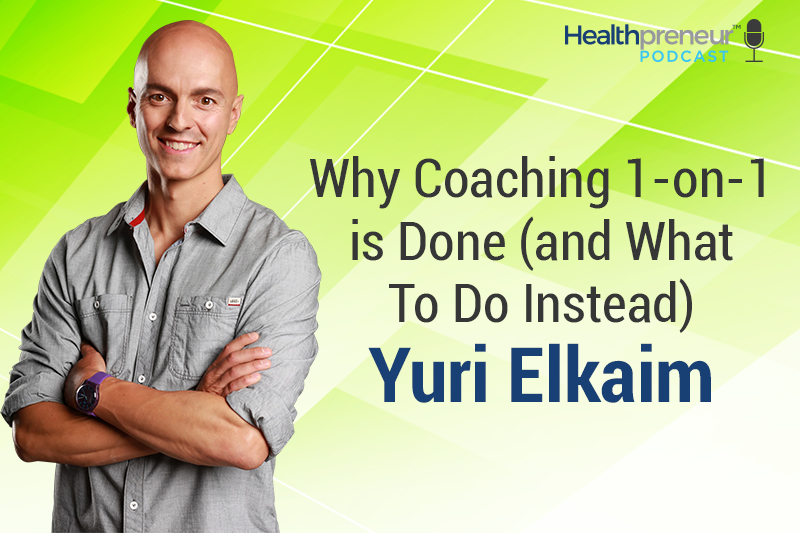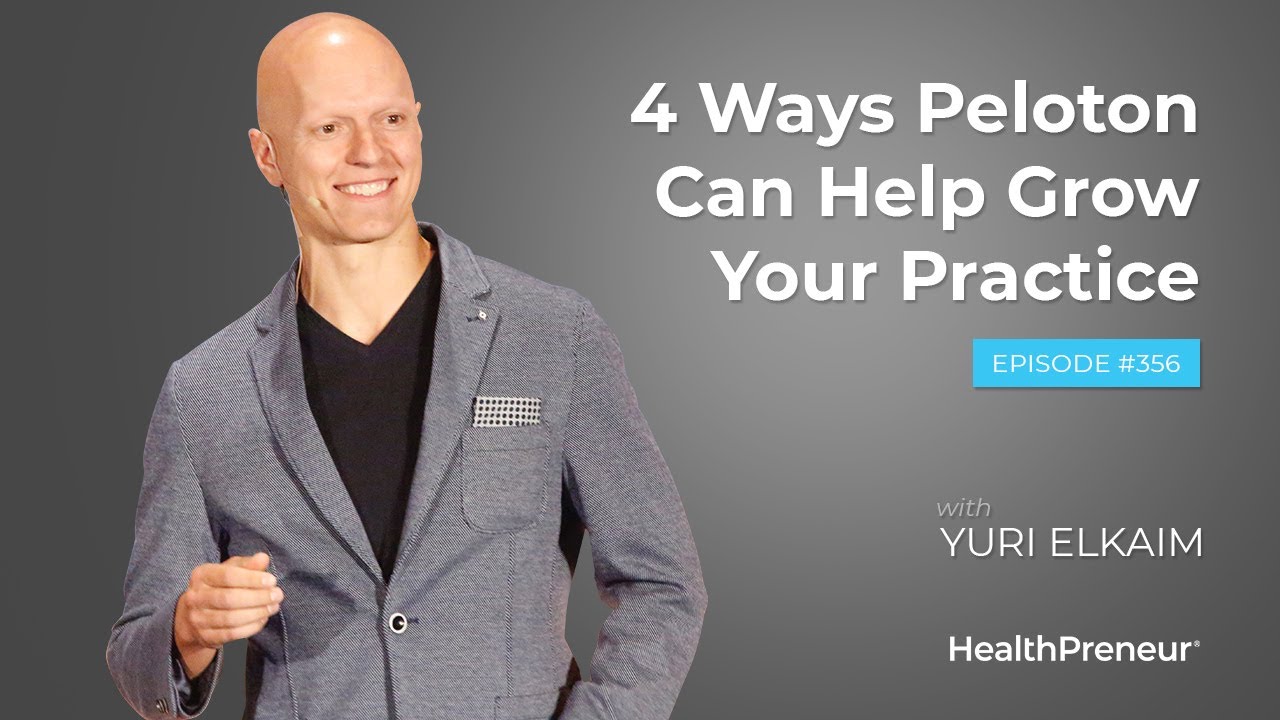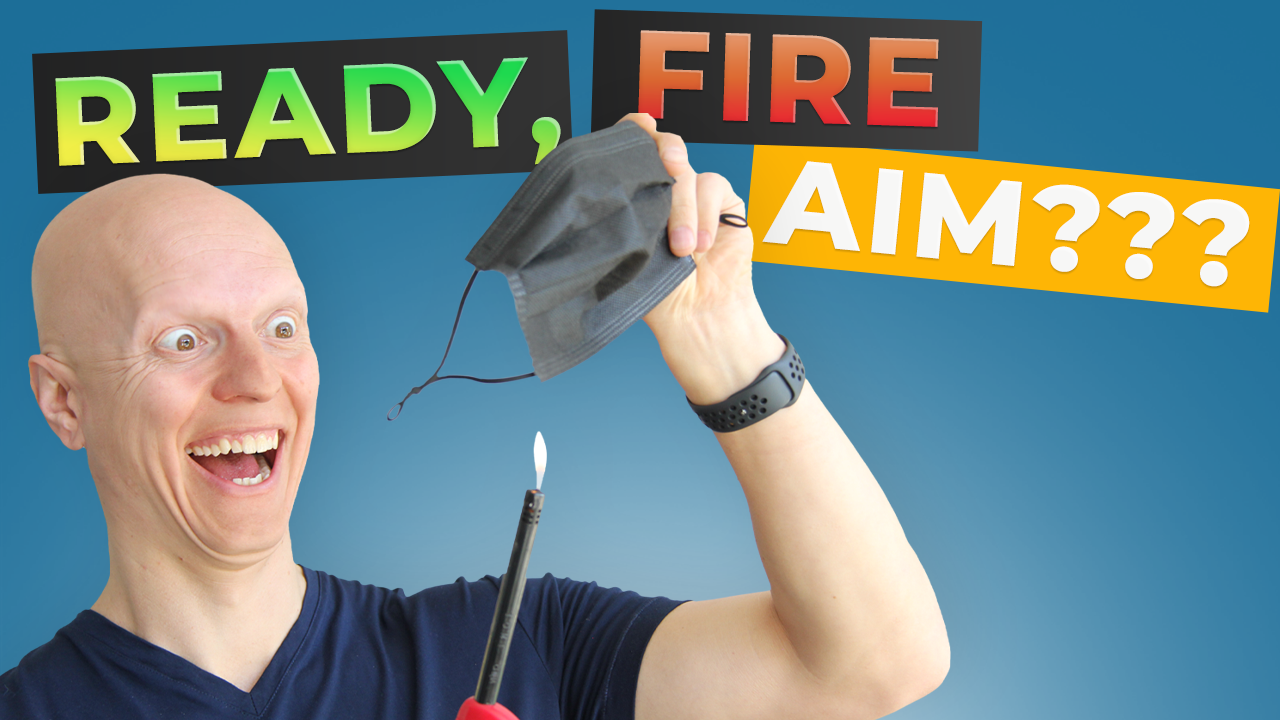Why Coaching 1-on-1 is Done (and What To Do Instead)

Happy Monday, Healthpreneurs! You know what that means—another solo round on the Healthpreneur Podcast! I hope you’re having a spectacular day. Get comfortable because I’m going to explain to you why coaching one-on-one is done. Out of style. History.
Why is coaching one-on-one done? Well, for one, everyone who has done it knows that it is exhausting. You put in a bunch of hours, your clients don’t get fast results —and, best of all, you don’t make as much money as you could. Sounds like a lose-lose scenario to me, right? By group coaching you work less, make more, and your clients get better results, an accountability network, and lasting relationships.
It’s an easy switch because, chances are, you are already going through a similar protocol with all or most of your existing one-on-one clients. I’m going to walk you through the steps to make group coaching the primary profit workhorse your business. The best part? It’s very simple. Just deliver on the back end once the system is in place. This episode is aimed at Healthpreneurs who are currently one-on-one coaching and Healthpreneurs that are group coaching but want to improve their business.
In this episode I discuss:
02:30 – 4:00 – The pitfalls of one-on-one coaching and why it’s done
4:00 – 6:00 – How to get into group coaching; identifying the target market and the problem
6:00 – 9:00 – Building a program with a proprietary process with Healthpreneur
9:00 – 11:00 – Your scalable deliverable and the client’s increased results
11:00 – 14:00 – The math behind group coaching: Better money and results, less work
14:00 – 16:00 – Healthpreneur workshops and business model
Transcription:
Today we’re talking about why coaching one-on-one is done, and what to do instead.
Welcome to the show, I’m excited to be with you once again. It’s warming up here in Toronto and I’m pumped because this is week two of our Health Business Accelerator online workshop. We run this workshop in two ways: We have a two-day live intensive, and a six-week online version that is also done live. This is the second week of the most current online program, and it’s a lot of fun.
I’m pumped to be working with the amazing health entrepreneurs, coaches, and practitioners that we have in the program, and helping them get a lot more clarity in their business and business model. We give them a business-in-a-box to help them attract their ideal clients, work with them at a closer level, and command premium prices for producing amazing results. It’s tremendous.
If you’re interested in joining one of our workshops, you can head on over to healthpreneurgroup.com/workshop.
The pitfalls of one-on-one coaching and why it’s done
Years ago, I fell out of love with one-on-one coaching.
I started out as a trainer, working one-on-one with clients, day in and day out. I had 12-hour days that were tiring and not fun. I did that for eight years. At the same time, I was the strength and conditioning coach for the men’s soccer team at the University of Toronto, and I enjoyed that for two reasons. Number one, I was working with athletes who wanted to be better, which was awesome. Two, I was working with a group, and I realized that I enjoyed working with groups of people.
There’s so much more synergy. It’s fun, it’s dynamic.
You don’t get into the psychotherapy sessions that one-on-one training or one-on-one coaching entails. If you’re doing any kind of one-on-one coaching, I promise you, you can relate to that.
There’s nothing wrong with people sharing their stuff. But you must stay on point. A lot of times, one-on-one coaching becomes an energy-draining therapy session, and that’s not what they’re for. We are there as coaches to keep people on track, call them out on their BS, get to the root of the issue, and move them forward.
I’m not saying not to be empathetic. Empathy’s very important, but we can’t sit in a stew of nonsense, stories, or stuff that doesn’t serve anyone, for half the session or even longer. That’s one of the biggest reasons people come to us.
They’re tired of one-on-one coaching. It’s wearing them down. They’re falling out of love with serving people, because they don’t want to do any more-one-on-one. We help our clients move from a one-on-one coaching model to a group coaching model, and this can be done in-person or online.
How to get into group coaching; identifying the target market and the problem
In order for a group coaching program to work, without working yourself into the ground in the process, you have to define a single target market and focus on solving a single pain or problem for them.
To serve 10, 20, 50, 100 people at the same time and make it feel like a personalized experience, it’s important to have everyone on the same track, going to the same destination. That way, you can create a dream come true system, a done-with-you program, that is the same for everyone.
If you’re a coach or a practitioner and you have some people who are trying to overcome diabetes, some people looking to build muscle, and some looking to get rid of back pain, now you’ve got three completely different train tracks and protocols that you would have to manage. That’s what happens when you don’t narrow things down. A problem I see in the health industry is that people fear alienation and want to help everyone.
You going to help everyone. You’re not even going to help yourself. It’s like going to a restaurant that is, “The Best Mexican, Italian, Japanese, American, and French food since 1995.” I’m not stepping into that kind of restaurant, but I’ll definitely go to the best Italian restaurant because it’s specialized. I know I’m going to get exactly what I want when it comes to Italian food.
In your business, first and foremost, understand the single target market you want to serve. How or who do you want to be known for? How do you want to be seen in the marketplace? Do you want to be the person that is known for helping people reverse Type 2 Diabetes, or do you want to be a health coach that helps people get healthy?
Building a program with a proprietary process with Healthpreneur
There’s a big difference. If people can’t clearly classify you out of all the different service providers, you’re going to have a tough time standing out and sticking in their minds. With Healthpreneur, we specialize in helping health entrepreneurs, coaches, and practitioners turn their expertise into thriving online coaching businesses.
That’s what I want to be known for. That’s it. I don’t want to help realtors or internet marketers. That’s not what I want to do. I’ve narrowly defined that market.
Another thing is that we don’t provide coaching anymore to people who want to sell information products. We’ve got a couple people in our mastermind who are still using that model, but in terms of attracting new clients, that’s not something we want to do. That’s not the model that we built out to help people.
If you’re selling an amazing supplement that we can position as an authority in the marketplace or a group coaching program, that’s our bread and butter. The first thing you need to identify is your single target market. Then, identify the pain or problem you want to help them solve. With that, you can build a program because the recipe, or the proprietary process, is the same.
We go through the steps to get people the results they’re after. But when you have all sorts of different clients, on all sorts of different tracks, you can’t do that. And you can’t scale that. In group coaching the way we teach it and help you implement it, you have your single focus, and you’re working with everyone on a single track towards a single destination. Because of that, you don’t need to customize a thousand different things.
The exception is someone, like a functional medicine doctor, who’s doing lab tests. In that case, you might throw in a one-on-one consult during your program to go over lab results and customize their program a little bit. But for the most part, if you’ve been training clients or seeing patients with a specific problem for years, you’ll generally prescribe the same protocol for all of them.
Your scalable deliverable and the client’s increased results
If that’s the case for you, then you have a recipe that can be duplicable and scalable. If you’re working one-on-one with someone and you can help them take the steps to overcome Diabetes, then that same process can be useful for a group of people doing the same thing. You can help 5, 10, 20, even 50 people at the same time with this type of process. That’s what we do, day in and day out, when we serve our clients and help them do that in their businesses.
The cool thing about group coaching is that it doesn’t take 40 hours a week to deliver. With the right setup, your deliverable, what you put into the business in terms of your coaching, is anywhere from two to four hours a week.
If you’re working with clients right now, one-on-one, and you’re burnt out working 30, 40 hours a week or more, I strongly recommend that you consider the coaching group model. It’s better for you.
You won’t deal with the one-on-one psychotherapy stuff. It’s better for your clients, because now they’re part of a group, where they’re accountable to each other and you, but they’re also having more fun. They’re making new relationships and friendships, and you never know what can happen.
The math behind group coaching: Better money and results, less work
I’ll give you a great example. In our February 2-day live intensive workshop in Scottsdale, the Health Business Accelerator, we had 15 amazing people. We had chiropractors, naturopaths, health coaches, and trainers. It was such a great group.
Something happened after the workshop that I never anticipated. This is why group coaching is so powerful. When we finished the workshop, they took it upon themselves to start doing group calls to make sure they were on track. How cool is that?
Just that alone is reason enough to move from one-on-one to group coaching. You have built-in support and accountability, and everyone’s working towards the same goal.
You can also scale this. One-on-one coaching, whether it’s done in-person or online, is not scalable. You can only work so many hours in a day.
Let’s use this example: Let’s say you could work a maximum of 40 hours a week, and you were charging $100 per person. For a lot of people, that’s still high, based upon the conversations I’ve had. That’s eight hours a day. That’s tiring. But let’s just say that’s that. So, if you’re working one-on-one with 40 people, that’s $4,000 of income. Not bad. Forty hours of work, so your effective hourly rate is $100.
Now let’s look at those same 40 people. Say we brought them to a group coaching program, and they are all working toward the same objective. Instead of individually telling them the same thing, you put together a program they all walk through that gives them the step-by-step towards that common outcome.
Instead of charging $100 per head, you charge $3,000 for an eight-week program to help them get the result that they want. Now you’ve got 40 people paying you $3,000 each. That’s $120,000 for the duration of that program. That’s over two months if we break it down by week. $120,000 divided by 8 weeks is $15,000.
If we do $4,000 a week one-on-one, that’s $16,000 in a month and $32,000 in two months. Now with a group coaching program, we’re saying it’s $120,000 in two months, but here’s the kicker: For two to four hours of your time per week. AND your clients are getting better results.
Please tell me why you would not want to do that! Even if we say it was four hours per week over the course of eight weeks, 32 hours, for $120,000, your effective hourly rate is $3,750. That’s a lot more.
To me, that makes all the sense in the world, so why would you ever want to do one-on-one coaching? People might ask if one-on-one coaching is more valuable for the client. The answer is no, it’s not.
If the client is just whining and complaining the whole session, they’re not moving forward towards their outcome. But if they’re in a group of people with support, friendships, and relationships, they’re not going to waste everyone’s time by bringing up issues that have no relevance on group calls.
Now you’re moving forward, and everyone’s supportive. They’re accountable to you, they’re accountable to their other peers, and there’s no wasting time. You make more money, they get a better result, you have way more free time. Boom! Done!

Healthpreneur workshops and business model
That’s why group coaching is the way to go. If you want help building out your group coaching program, that’s what we do. That’s what we help you do in our workshop. If you want to apply to attend one of our upcoming workshops, go over to healthpreneurgroup.com/workshop, and we’ll give you all the information on the page.
If you feel it’s a good fit for you, apply. We’ll have a quick follow-up call and confirm your spot. We’ll literally hold your hand, step-by-step, and help you build out your program. We’ll show you exactly how to track clients, 24/7, predictably, how to deliver an amazing experience for them, and automate your entire business.
We’re moving people to an automated way of attracting leads. We use Facebook ads. We bring them into an automated webinar, and we get people onto the phone to enroll with you.
That’s it! Then you deliver on the backend. It’s an amazing business model. It’s exactly what we do with Healthpreneur and what we help our clients do. If you’re interested in that, you can make a lot more money in a lot less time, without compromising the results you’re getting for your clients. In fact, you’re promising better results and better experience for your clients. We’d love to serve you.
If that’s your interest, check out the workshop. In the meantime, thank you for joining me.
We’ve got a great episode coming up on Wednesday with Nicholas Bearly. He’s going to be talking about how to charge premium prices for health coaching. He’s doing some cool stuff with entrepreneurs, and you’ll be surprised at some of the stuff that he’s doing and charging within that market.
So, if you think your market won’t pay for what you want to do, just listen to Wednesday’s episode and go back to episode 72, where I talked about how to charge premium prices, even if you’re not a guru.
This is big stuff. So, subscribe to the Healthpreneur Podcast if you haven’t done so already. Head on over to iTunes and hit the subscribe button. You don’t want to miss any more of this goodness, do you? This has been a lot of fun; I hope you’ve enjoyed it. I will see you on Wednesday.
In the meantime, continue to go out there, be great, and do great, and we’ll see you then.
If you enjoyed this episode, head on over to iTunes and subscribe to Healthpreneur™ Podcast if you haven’t done so already.
While you’re there, leave a rating and review. It really helps us out to reach more people because that is what we’re here to do.
What You Missed
Our last episode featured co-founder and co-host of the Ultimate Health Podcast, the one and only Marni Wasserman.Outside of being a fun and entertaining host of a successful podcast, Marni is also a nutritionist and natural chef.
Although she loves cooking and teaching, Marni found a new passion in podcasting.
Marni started as an owner of a cooking school and author of two books. But when she recognized that her brick and mortar business wasn’t lending itself well to the lifestyle she desired, she opted for something different. As she transitioned out of her cooking school, Marni transitioned into the Ultimate Health Podcast, and she hasn’t looked back since.
Today, Marni and her husband proudly run a wildly successful podcast. She is excited to continue building out its brand to extend to an entire wellness space—complete with products, live events, and speaking engagements all over the world.
We jumped into podcasting behind-the-scenes, the growth that comes from in-person to online work, and the necessary traits to succeed in any business.
If you’ve ever been curious about podcasting or already have a podcast and want to learn how to take your podcast to the next level, this episode is a must listen.
Related posts
September 28, 2018
How Brain Health Coaching Can Transform Your Clients and Your Business with Ryan Glatt
Welcome to the Healthprener…





